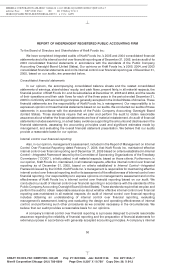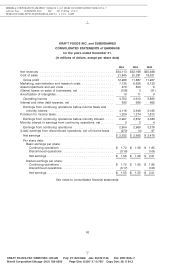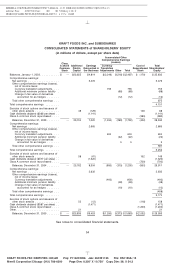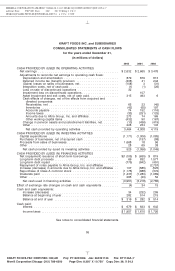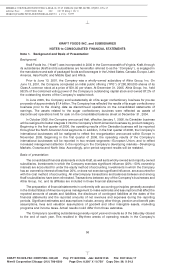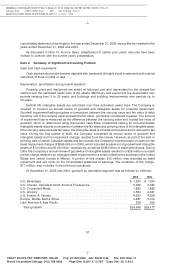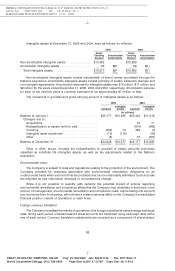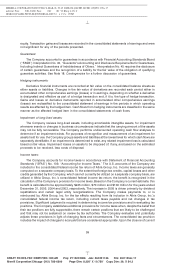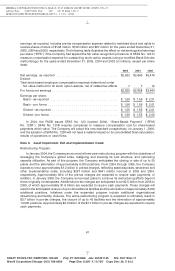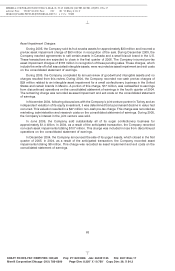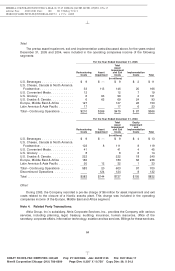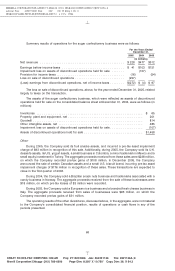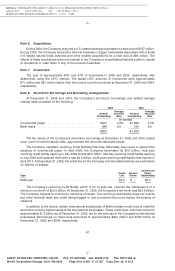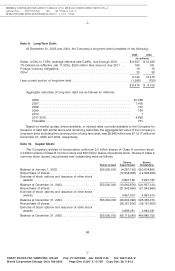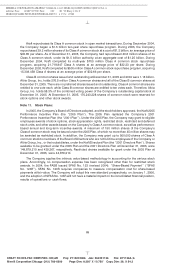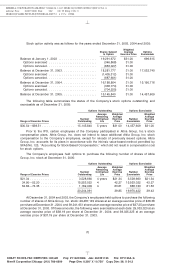Kraft 2005 Annual Report Download - page 61
Download and view the complete annual report
Please find page 61 of the 2005 Kraft annual report below. You can navigate through the pages in the report by either clicking on the pages listed below, or by using the keyword search tool below to find specific information within the annual report.
MERRILL CORPORATION EYOUNG// 8-MAR-06 09:45 DISK126:[06CHI5.06CHI1135]DU1135A.;17
mrll.fmt Free: 110D*/120D Foot: 0D/ 0D VJ RSeq: 5 Clr: 0
DISK024:[PAGER.PSTYLES]UNIVERSAL.BST;51
KRAFT FOODS-FSC CERTIFIED-10K/AR Proj: P1102CHI06 Job: 06CHI1135 File: DU1135A.;17
Merrill Corporation/Chicago (312) 786-6300 Page Dim: 8.250 X 10.750Copy Dim: 38. X 54.3
and future tax audits in various jurisdictions, significant income tax accrual reversals could continue to
occur, which could trigger reimbursements from Altria Group, Inc.
Inventories:
Inventories are stated at the lower of cost or market. The last-in, first-out (‘‘LIFO’’) method is used to
cost a majority of domestic inventories. The cost of other inventories is principally determined by the
average cost method.
In 2004, the FASB issued SFAS No. 151, ‘‘Inventory Costs.’’ SFAS No. 151 requires that abnormal
idle facility expense, spoilage, freight and handling costs be recognized as current-period charges. In
addition, SFAS No. 151 requires that allocation of fixed production overhead costs to inventories be
based on the normal capacity of the production facility. The Company is required to adopt the provisions
of SFAS No. 151 prospectively as of January 1, 2006, but the effect of adoption will not have a material
impact on its consolidated results of operations, financial position or cash flows.
Marketing costs:
The Company promotes its products with advertising, consumer incentives and trade promotions.
Such programs include, but are not limited to, discounts, coupons, rebates, in-store display incentives
and volume-based incentives. Advertising costs are expensed as incurred. Consumer incentive and
trade promotion activities are recorded as a reduction of revenues based on amounts estimated as
being due to customers and consumers at the end of a period, based principally on historical utilization
and redemption rates. For interim reporting purposes, advertising and consumer incentive expenses are
charged to operations as a percentage of volume, based on estimated volume and related expense for
the full year.
Revenue recognition:
The Company recognizes revenues, net of sales incentives and including shipping and handling
charges billed to customers, upon shipment or delivery of goods when title and risk of loss pass to
customers. Shipping and handling costs are classified as part of cost of sales.
Software costs:
The Company capitalizes certain computer software and software development costs incurred in
connection with developing or obtaining computer software for internal use. Capitalized software costs
are included in property, plant and equipment on the consolidated balance sheets and amortized on a
straight-line basis over the estimated useful lives of the software, which do not exceed five years.
Stock-based compensation:
The Company accounts for employee stock compensation plans in accordance with the intrinsic
value-based method permitted by SFAS No. 123, ‘‘Accounting for Stock-Based Compensation,’’ which
has not resulted in compensation cost for stock options. The market value at date of grant of restricted
stock and rights to receive shares of stock is recorded as compensation expense over the period of
restriction (three years).
At December 31, 2005, the Company had stock-based employee compensation plans, which are
described more fully in Note 11. Stock Plans. The Company applies the recognition and measurement
principles of Accounting Principles Board Opinion No. 25, ‘‘Accounting for Stock Issued to Employees,’’
and related Interpretations in accounting for stock options within those plans. No compensation
expense for employee stock options is reflected in net earnings, as all stock options granted under those
plans had an exercise price equal to the market value of the common stock on the date of grant. Net
60
6 C Cs: 47208


